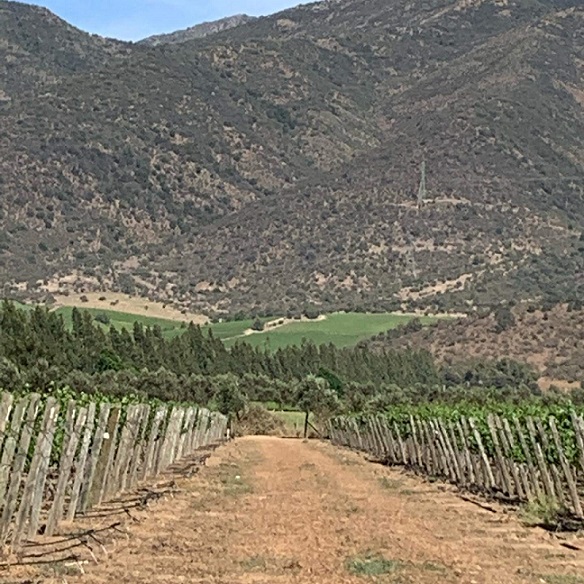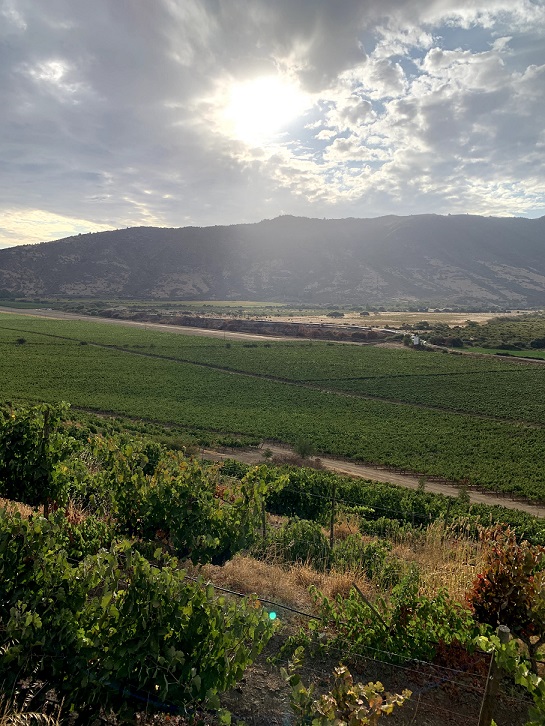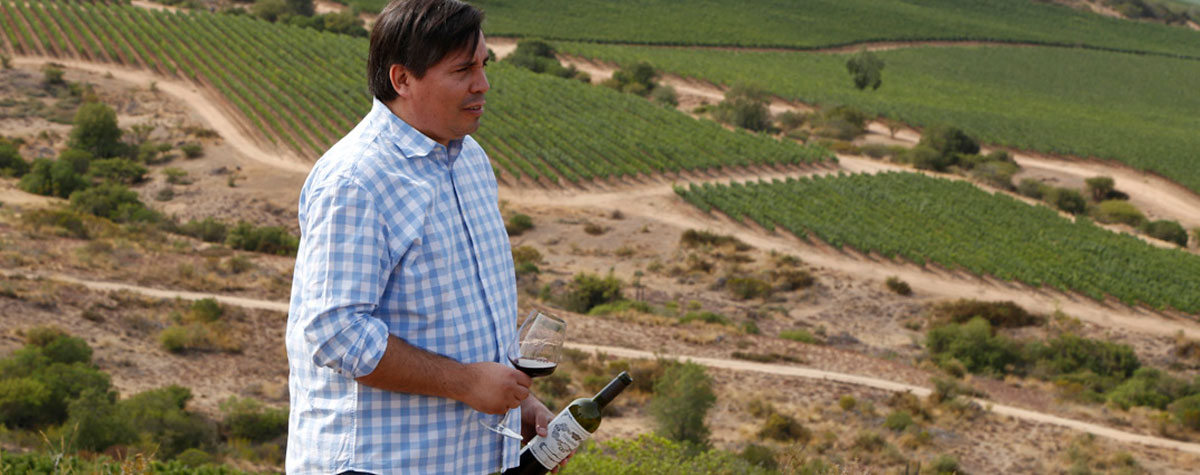Marceló is the head winemaker at TerraNoble, which was founded in 1993 by a group of wine lovers headed up by Jorge Elgueta with the aim of crafting premium Merlot and Sauvignon Blanc in the Maule Valley. When Chile discovered much of its distinctive Merlot was, in fact, Carmenère in 1994, TerraNoble – unlike many other producers – did the noble thing and embraced the forgotten French variety.
So much so, in fact, that since businessman Wolf von Appen took over in 2006 and expanded the vineyard holdings to the current 300ha, with additional sites in the Casablanca and Colchagua valleys, TerraNoble has also expanded its range of Carmenères.
There are now Carmenère varietals at four levels: reserva, reserva especial, gran reserva and premium.
The premium series, its CA project, explores the terroir at a similar latitude in the Colchagua Valley, and the influence of the Andes Mountains and Pacific Ocean in vineyards that are only 70km (43.5 miles) apart but have completely different soils, mesoclimates and altitudes.
Marceló, who previously worked at Chilean wineries Concha y Toro, Valdivieso, Santa Carolina and San Pedro, says they have moved a long way from the country’s early Carmenères, when winemakers were “afraid of” pyrazines so they either pushed back the picking dates to the middle of May and went for the more opulent, jammy style, or they masked the pyrazines with lots of new oak.
'Almost half of what is purchased now is untoasted'Both approaches, he says, failed to show the variety’s true expression – wines that stand out for their fruit, acidity, elegance and complexity. To make such wines, he has been experimenting with the harvest dates, vineyard management of various plots and the vessels used for ageing. The size, brands, and toasting of the barrels were among the first things changed. “Almost half of what is purchased now is untoasted,” Marceló tells Canopy. He has also upped the number of foudres, increased their sizes and changed their shape – and is currently experimenting with amphorae and cement eggs (more below).
The CA project


Started in 2009, the CA project explores two different expressions of Carmenère in the Colchagua Valley, from a large vineyard on coastal hills (at Lolol, just over 40km from the sea) and a relatively small vineyard in the foothills of the Andes (at Los Lingues).
From these sites, two single-vineyard wines, CA1 Andes (above) and CA2 Costa (below), are released. Both undergo similar vinification, production and ageing. “The target is to show the terroir, different expressions of Carmenère in a good way with high quality,” Marceló says.


Some key details of the winemaking
- Cold maceration: “To carry out the pre-fermentation maceration in cool conditions, low doses of SO2 are added, the fruit is cooled to 6-8°C and we add carbon snow to the tank. During maceration, punchdown is carried out to homogenise the temperature and colour extraction. In 2020, we included in some of the macerations 5% of whole bunches, with very mature stalks,” Marceló explains.
- Ageing: The 2016 vintages went 85% in new and twice used French oak and 15% in untoasted foudres for 14 months; for the current release, 2017, it was 80% barrels, 20% foudres; and 2018 is currently resting in 70% barrels, 30% foudres. The barrel sizes have also been increased from 225 to 300L and half are untoasted.
- Bottle ageing: Minimum 12 months before release.
- Production: 8,000 bottles each per year (compared to the IWC Chilean Red Trophy-winning Gran Reserva’s 80,000 bottles per year).
But Marceló is relishing the opportunity to play with the variety and admits this project has made him fall in love with Carmenère again. For an example of how the fine-tuning has progressed, here’s what he says about the vessels used for ageing...
Vessels
In recent years, Marceló and his team have been tinkering with the percentages going into barrels and foudres and the sizes of the barrels and the size and shape of the foudres. The percentage of wine going into foudres has increased by 5% each year since 2016, from 15 to 30%. And the reduced volume going into barrels is going into larger barrels – 300L instead of the previous 225L.Marceló explains: “The most important thing in this project of CA1, CA2 is to show the terroir so when you use foudres you know you have less surface contact between the wine and wood, so you can keep the classic notes from the Carmenère but at the same time you can work the structure and body.”
He adds: “As of harvest 2016, the use of 2,000L foudre was included in the CA project. In subsequent harvests we have used 2,500 and 3,500L foudres – all round, since I like the way the structure of the wines works compared to the oval ones.
“The 2018 harvest was a normal climate year, without rain and with average temperatures, which allowed a slow maturity, with high acidity and interesting fresh fruit, favouring almost 30% foudres and the rest in 300L barrels of first and second use.”
Wanting “to keep the best expression of the fruit and typicity of the grape”, Marceló has started experimenting with other materials. He states: “In the 2019 and 2020 harvests we used clay amphorae and concrete egg vats for different Carmenères. So far, I have seen better results in CA2 Costa. I think this is because of the granite (soil) giving the wine an unexpected minerality. We still need to understand the interaction of these containers in CA1 Andes. We are working on it, hoping that the 2020 vintage will include a percentage of them in the blend.”
He summarises the different options this way:
- Foudres – “respect of the fruit, elegance and volume”;
- Cement egg – “amplifies minerality and tension”;
- Amphora – “preserves fruit, complexity, also minerality, but a different type of tannin than the egg”.
'I want to transmit the characteristics of the variety and the terroir into the bottle'
The vineyards
Marceló concedes that the vineyards are the most important part of this project. “When I began my career, I thought that the wines were made in the winery, but over time I realised that the protagonist is the grape, the place, the soil, the climate.“It is fundamental to understand what is happening in the fields and plants, and to see how they evolve. You need to have them happy.
“When I walk the vineyards, I look and taste the grapes. I sense the evolution and define what I am going to do in the winery, defining the maceration, fermentation temperature, whether it will be native yeast, full bunch, extraction and if I will use foudres, barrel, amphorae, or eggs.
“I want to transmit the characteristics of the variety and the terroir into the bottle.”
Although the vinification and ageing are the same for CA1 and CA2, there is a slight difference regarding the vineyard management. “Pruning is the same – two shoots with 7-8 buds each,” he says. “Fertilisation will be associated with foliar and soil analysis. Due to the morning sun, leaf removal is similar. For me, the biggest difference in the vineyard is irrigation given the quite different soil profiles. CA1 comes from clay soil of medium to high depth and is watered two to three times in the season, unlike CA2 coming from a thin, granite soil, which forces us to water every seven to 10 days.”
Whether we are talking about the vineyards or ageing vessels, Marceló’s passion for the project and grape variety are clear. TerraNoble may “still have a long way to go”, but it’s also clear how far it has come.













.png)






